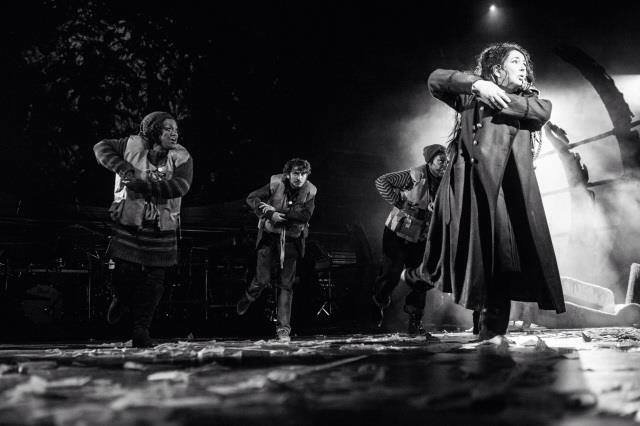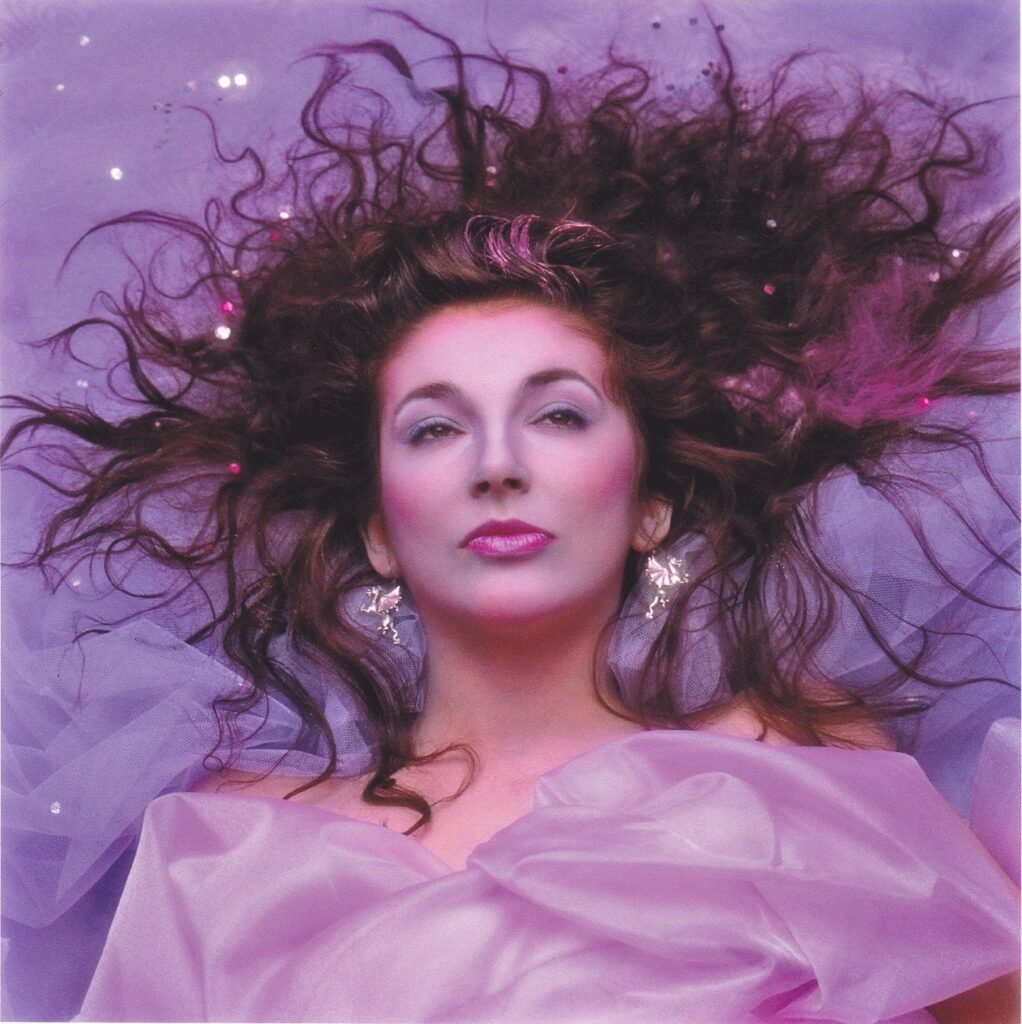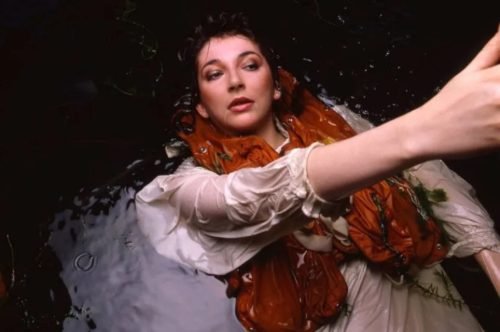Kate Bush is not just a musician; she is a phenomenon. Since her debut in 1978 with the enigmatic “Wuthering Heights,” Bush has carved out a niche of her own in the music world, blending classical influences with avant-garde pop and an ethereal performance style. Her work is characterized by its experimental spirit, thematic depth, and an unyielding pursuit of artistic authenticity. Bush’s oeuvre is a testament to her role as an innovator who continually pushes the boundaries of what pop music can achieve in narrative and emotional depth. One of her most compelling and intricate offerings is The Ninth Wave, the concept suite that forms the second side of her acclaimed 1985 album, Hounds of Love.
This suite is a remarkable narrative arc—spanning seven tracks, it tells the story of a woman lost at sea, fighting against the tides of despair and isolation in a bid for survival. Each track serves as a vignette, a window into the protagonist’s soul, exploring themes of fear, hallucination, and the human spirit’s resilience.
We will explore how Bush uses an array of musical styles to mirror the psychological landscape of her protagonist, from the haunting quietude of “And Dream of Sheep” to the vigorous hope of “Jig of Life”. A close examination of the lyrics will reveal the rich symbolism and psychological nuances embedded in the narrative. This analysis is designed not only to appreciate Bush’s artistic achievements but also to provide insights into how her musical storytelling captures universal human experiences, making The Ninth Wave a timeless piece of art that continues to resonate with audiences today.
The Genesis of The Ninth Wave

Kate Bush’s The Ninth Wave is not merely a collection of songs but a carefully woven tapestry of intricate narratives and emotional landscapes. The origins of this ambitious piece trace back to Bush’s fascination with storytelling and her desire to create a musical experience that transcends conventional songwriting. In various interviews, Bush has expressed that the inspiration for The Ninth Wave stemmed from multiple sources, including literature, film, and personal introspection. One notable influence was the 1975 film adaptation of The Poseidon Adventure, which sparked her interest in the themes of survival and the human condition in face of dire adversity.
The Ninth Wave begins with the protagonist inadvertently cast into the sea, following a maritime accident, and unfolds over the course of one night. This dramatic sequence starts with “And Dream of Sheep,” where the protagonist, fighting hypothermia, tries to stay awake amidst the gentle but menacing lull of the sea. The narrative progresses through various stages of consciousness and subconsciousness, encapsulated in tracks like “Under Ice,” where she finds herself trapped under a frozen landscape, and “Waking the Witch,” which introduces elements of trial and judgment. The sequence crescendos with “Jig of Life,” a powerful invocation of future and past selves battling against the pull of death.
Each song is a vignette that combines to form a larger, more complex story about the struggle between life and death, reality and hallucination, fear and courage. Bush’s crafting of The Ninth Wave was not only a narrative achievement but also a technical one, as she experimented with pioneering recording techniques to capture the ebb and flow of the protagonist’s journey.
Musical Landscape

Kate Bush’s The Ninth Wave is a masterclass in musical diversity, where each track not only advances the narrative but also shifts through a spectrum of sonic landscapes. The varied musical styles and the intricate instrumentation that Bush uses create and emotional and thematic depth.
Varied Musical Styles
Each piece within The Ninth Wave is distinguished by its unique musical style, which mirrors the psychological and physical states of the protagonist.
“And Dream of Sheep”
Features minimalistic yet chilling synths and a tender piano that lay the groundwork for a soundscape resembling the cold, isolating sea. The simplicity of the arrangement enhances the vulnerability and exhaustion felt by the protagonist.
“Under Ice”
Starkly contrasts with its predecessor through a sudden, intense burst of strings and an urgent vocal delivery. The music here is sharper, faster, mimicking the sudden terror of finding oneself trapped under a sheet of ice.
“Waking the Witch”
Employs a barrage of sound effects, overlapping voices, and a driving beat, creating a cacophony that reflects the chaos and confusion of a witch trial. This track is particularly notable for its aggressive synthesizer work and a dramatic shift in tone that introduces a darker, more menacing element to the narrative.
“Watching You Without Me”
Uses an ethereal mix of electronic loops and ghostly vocals to create a sense of disconnection and spectral presence, enhancing the narrative’s theme of ethereal, almost out-of-body observation.
“Jig of Life”
Bursts with energy, featuring robust orchestral movements and traditional Irish folk elements. The bodhrán and fiddles lend a visceral, earthy quality that roots the song in a life-affirming force, embodying the protagonist’s plea to survive.
“Hello Earth”
Is one of the most atmospheric tracks in the suite, where Bush employs a mix of ambient sounds, choral arrangements, and echoing vocals to create a sense of vastness and awe. The incorporation of a traditional Georgian folk song, “Tsintskaro,” within the track serves to anchor the otherworldly texture of the music, providing a deep, ritualistic quality that mirrors the thematic exploration of connecting with the earth and the cosmos.
“The Morning Fog”
Marks the resolution of the suite with a bright, uplifting melody that contrasts sharply with the preceding tracks. This song features acoustic guitar, light percussion, and warm vocal harmonies, symbolizing renewal and rebirth. The simplicity and directness of the music reflect the clarity and gratitude of the protagonist as she emerges from her ordeal, reaffirming her connection to her loved ones and to life itself.
Instrumentation and Arrangement

Bush’s choice of instrumentation and vocal arrangements throughout The Ninth Wave is meticulously aligned with the narrative’s emotional trajectory.
The use of synths in tracks like “And Dream of Sheep” and “Waking the Witch” varies from soothing to startling, demonstrating Bush’s ability to manipulate electronic sounds to evoke specific emotional responses.
Acoustic elements such as the piano in “And Dream of Sheep” and strings in “Under Ice” provide warmth or tension, respectively. The stark contrast between the warmth of acoustic sounds and the coldness of the synths plays a crucial role in conveying the suite’s emotional and thematic contrasts.
“The Morning Fog” uses its instrumentation to celebrate the protagonist’s survival and return to the world of the living. The acoustic guitar and the clear, bright vocals in this closing track bring a sense of lightness and hope, a stark contrast to the darker, denser textures of the earlier songs. This arrangement not only concludes the narrative on a note of optimism but also reflects a musical awakening paralleling the thematic rebirth.
In “Hello Earth,” the orchestration builds layers of complexity with a combination of synthesizers, strings, and the haunting choral section. This layering creates a dense, immersive soundscape that envelops the listener, simulating the protagonist’s envelopment by the sea and her transcendental connection to the earth.
Vocal Arrangements
The vocal arrangements are particularly noteworthy. Bush layers her voice in many of the tracks, creating harmonies that range from comforting to haunting. In “Waking the Witch,” the overlapping voices contribute to a sense of internal conflict and external accusation, while in “And Dream of Sheep,” the solitary, clear vocal line underscores the loneliness of the protagonist’s plight.
The vocal delivery in “Hello Earth” switches between direct and echoing, simulating communication between different planes of existence — the earthly and the ethereal. This is effectively complemented by the somber tones of the choir, which adds a solemn, almost sacred dimension to the track.
“The Morning Fog” uses its instrumentation to celebrate the protagonist’s survival and return to the world of the living. The acoustic guitar and the clear, bright vocals in this closing track bring a sense of lightness and hope, a stark contrast to the darker, denser textures of the earlier songs. This arrangement not only concludes the narrative on a note of optimism but also reflects a musical awakening paralleling the thematic rebirth.
Kate Bush’s The Ninth Wave is an exemplary showcase of how varied musical styles and thoughtful instrumentation can be employed to enhance the storytelling in music. Each track, with its distinct sound and arrangement, crafts a chapter of the larger narrative, making the suite a compelling journey through sound and story.
Lyrical Deep Dive

Kate Bush’s The Ninth Wave is a lyrical odyssey that complements its complex musical landscape. This suite uses poignant and evocative lyrics to navigate a narrative of survival, fear, and rebirth, employing a rich tapestry of symbols like water, light, and darkness.
Track by Track Analysis
“And Dream of Sheep”
Opens with the protagonist seeking to keep herself awake to avoid slipping into the cold embrace of the sea. The lyrics, “Little light shining / Little light will guide them to me,” evoke a beacon of hope amid desperation. The reference to light here symbolizes life and guidance, contrasting with the encompassing darkness of the sea.
“Under Ice”
Is stark and visceral, where the lyrics paint a chilling picture: “It’s wonderful / Everywhere so white / The river has frozen over.” Here, the ice represents both a physical barrier and a metaphorical freezing of the senses as the protagonist confronts her own mortality.
“Waking the Witch”
Features a trial by a chorus of accusatory voices. The lyrics, “I question your innocence/ She’s a witch” highlight themes of judgment and the internal battle between life and surrender. The witch metaphor explores societal and self-imposed judgments that one might battle during moments of vulnerability.
“Watching You Without Me”
Delves into themes of separation and helplessness. The protagonist observes her loved ones from afar, unable to communicate: “You can’t hear me / You can’t feel me.” This track explores the ethereal disconnect between body and spirit during extreme isolation.
“Jig of Life”
Is an impassioned plea from the future self to the present, urging her to survive: “This moment in time / It doesn’t belong to you.” These lyrics affirm life’s cyclical nature and the imperative of enduring hardships to witness the fruition of one’s life.
“Hello Earth”
Includes the chorus from the Georgian folk song and the repeated calling, “Hello Earth! / With just one hand held up high.” The earth is personified and revered, suggesting a universal connection and a return to the basics of existence, underscoring a theme of rebirth.
“The Morning Fog”
Represents the resolution of the ordeal, with the protagonist expressing gratitude and renewed love: “I’ll tell my loved ones/ I’ll tell my brothers how much I love them.” The lyrics signify a rebirth, a clearing away of the perilous past, and an embrace of the light of a new day.
Themes and Symbolism
Throughout The Ninth Wave, Bush explores several recurring themes:
Survival and Vulnerability: The suite’s narrative revolves around the struggle for survival against overwhelming odds, with vulnerability poignantly expressed through the protagonist’s solitary and perilous night at sea.
Fear and Courage: These two emotional extremes are explored in depth, particularly in tracks like “Under Ice” and “Waking the Witch,” where the protagonist faces both external dangers and internal demons.
Rebirth: This theme culminates in “The Morning Fog,” where the protagonist, having survived, sees the world anew. This symbolizes not only survival but a transformation and renewal of life and purpose.
Symbols such as water, light, and darkness are masterfully woven into the lyrics. Water is ever-present, representing both danger and a medium of transformation. Light, often mentioned during moments of hope, symbolizes life, guidance, and safety. Darkness, conversely, is associated with fear, unknown depths, and isolation.
The Protagonist’s Psychological Journey

In Kate Bush’s The Ninth Wave, the protagonist’s journey is not only a physical battle against the elemental forces of nature but also a profound psychological odyssey.
Emotional and Psychological Progression
“And Dream of Sheep”
The suite opens where the protagonist is desperately trying to stay awake and alive. The gentle, lulling music juxtaposed with the lyrics conveying a struggle against the enveloping darkness sets the stage for a journey of survival. This opening track captures a state of vulnerability and weariness, highlighting the initial fear and resignation to fate.
“Under Ice”
There is a palpable shift to a more immediate danger. The protagonist’s fear becomes more pronounced as she encounters herself trapped beneath the ice. The music here is sharp and quick, mirroring the sudden surge of adrenaline and terror that comes with this realization.
“Waking the Witch”
Represents a critical point in the psychological journey. The introduction of harsh voices and a trial-like scenario through the music and lyrics introduces a confrontation with inner demons and societal judgments. This track signifies a moment of intense psychological turmoil and self-doubt, where the protagonist is forced to face her deepest fears head-on.
“Watching You Without Me”
Provides a moment of introspective pause. The ethereal, echoing music and lyrics suggest a disconnection from reality, reflecting the protagonist’s spectral presence and her helplessness as she observes her loved ones from afar. This track conveys a profound sense of loss and the surreal experience of being caught between life and death.
“Jig of Life”
Is a vehement assertion of the will to live. The robust, lively music and the persuasive lyrics from the future self inject a renewed vigor and determination into the narrative. This song represents a turning point where despair begins to transform into hope and resolve.
“Hello Earth”
Revisits the theme of connection and universality, with the chorus and orchestration creating a sense of awe and vastness. This track explores the acceptance of one’s smallness in the grand scheme of things and fosters a sense of peace with the inevitability of life’s cycle.
“The Morning Fog”
The journey concludes with “The Morning Fog,” where the music shifts to a light, hopeful tone, and the lyrics express gratitude and a rekindled love for life and family. This final track captures the protagonist’s rebirth—emerging from the psychological depths of her ordeal with a new appreciation and a clearer vision of what matters most.
Reflection in Music and Lyrics
Throughout The Ninth Wave, the music and lyrics are intricately woven to reflect the protagonist’s internal state. Each track uses specific musical elements—whether the chilling synths, the discordant voices, or the warm acoustic melodies—to echo the emotional and psychological shifts experienced by the protagonist. The suite travels through a spectrum from despair to hope, and finally to a resolution that, while hopeful, retains an element of ambiguity. This ambiguity is felt in the lingering effects of the ordeal, suggesting that while the immediate danger has passed, its emotional impact continues to resonate.
Production Techniques

Kate Bush’s The Ninth Wave is not only a triumph of songwriting and performance but also a showcase of pioneering production techniques. In this suite, Bush’s meticulous production choices and the use of innovative recording techniques serve to enhance the thematic depth and emotional resonance of the music.
Innovative Recording Techniques
Kate Bush employed a variety of innovative recording techniques to capture the complex emotional layers and sonic landscapes of The Ninth Wave. One of the most notable techniques is her use of the Fairlight CMI, an early digital synthesizer and sampler, which was revolutionary at the time. This instrument allowed Bush to weave intricate sound textures and to incorporate a range of sampled sounds that added a unique depth to the tracks. For example, the use of non-traditional sounds like breaking glass and the barking dogs in “Waking the Witch” heightens the sense of chaos and disorientation within the narrative.
Another significant technique was her pioneering use of the headset microphone in the studio, which allowed her to record more dynamic vocal performances. This was particularly effective in capturing the intimacy and varying emotional intensities of the suite’s vocals, from the whispered fears in “And Dream of Sheep” to the vehement cries in “Waking the Witch”.
Layering and Soundscapes
Bush’s production on The Ninth Wave is characterized by complex layering of vocals and instruments, creating dense soundscapes that mirror the protagonist’s psychological and physical journey. In tracks like “Hello Earth”, the layering of vocals with the haunting choral arrangement creates a sense of vastness and depth, simulating the protagonist’s feelings of being overwhelmed and small against the enormity of the earth and sea.
Sound effects play a crucial role in enhancing the narrative and thematic elements of the suite. The use of reverb, for instance, is masterfully manipulated to give a sense of space and isolation, particularly in “And Dream of Sheep”, where the sound of water and the distant ringing of buoys create an immersive aquatic environment. The echoing effects used in “Watching You Without Me” enhance the ghostly, otherworldly feeling of being present yet absent, perfectly capturing the surreal experience of the protagonist.
Use of Traditional and Non-traditional Instruments
The inclusion of traditional instruments like the bodhrán and uilleann pipes in “Jig of Life” ties the track back to Bush’s Irish roots, while simultaneously imbuing the song with a raw, primal energy that reinforces the theme of clinging to life. Conversely, the use of modern synthesizers alongside classical orchestration blurs the lines between contemporary and classical music styles, creating a timeless quality that is both modern and deeply evocative.
Kate Bush’s production choices in The Ninth Wave effectively fuse technology, traditional instrumentation, and innovative sound design to create a sonic landscape that is as vast and deep as the ocean itself. These elements work in concert to not only tell a story but to make the listener feel deeply embedded within it, proving that Bush’s production techniques are as integral to the suite’s impact as its lyrics and compositions.
Impact and Legacy

Kate Bush’s The Ninth Wave, the ambitious and evocative suite from her 1985 album Hounds of Love, has left an indelible mark on the landscape of music, both at the time of its release and in the decades that followed. This section explores the critical reception of the suite, its influence on other artists, and its enduring legacy as a pioneering work of art.
Critical Reception
Upon its release, The Ninth Wave was met with widespread acclaim, hailed for its innovative approach and profound emotional depth. Critics and listeners alike were captivated by Bush’s ability to fuse classical music influences with pop sensibilities, creating a work that was both accessible and artistically complex. The narrative coherence of the suite, combined with its rich musical tapestry, was particularly noted for its originality and daring. The suite’s exploration of themes such as survival, introspection, and rebirth resonated deeply, with many recognizing Bush’s work as a significant departure from mainstream pop and rock narratives of the time.
Influence on Other Artists
Kate Bush’s influence on subsequent generations of musicians has been profound and far-reaching. Bush’s bold use of narrative in The Ninth Wave encouraged other musicians to experiment with concept albums and to explore more complex and personal themes in their work. Her impact is particularly evident in how artists approach the album as a holistic art form—something to be experienced in its entirety rather than a collection of individual songs.
Legacy and Place in Music History
The suite’s place in music history is secured not just by its innovative sound and production techniques but also by its daring to engage with existential and deeply human questions through the medium of pop music. It stands as a testament to the potential of music to transcend entertainment and provoke thought, emotion, and conversation.
Overall, The Ninth Wave remains a testament to Kate Bush’s genius, an enduring legacy that continues to inspire and influence the music industry, proving that true artistry involves not only great music but the courage to tell compelling, human stories.
